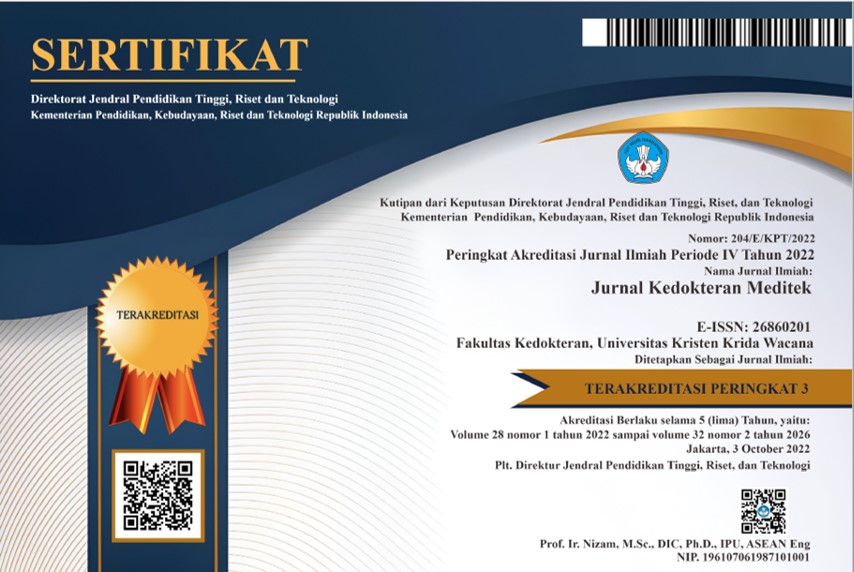Fibroadenoma Mammae: Prevensi Berdasarkan Karakteristik dan Faktor Risiko
DOI:
https://doi.org/10.36452/jkdoktmeditek.v30i1.2613Keywords:
faktor risiko, fibroadenoma mammae, karakteristik, prevensiAbstract
Fibroadenoma mammae (FAM) merupakan masalah kesehatan tumor jinak terbanyak dialami oleh wanita dan memiliki prevalensi tinggi di Indonesia. Tujuan penulisan, untuk mempelajari karakteristik dan faktor risiko terkait kejadian FAM serta menyusun sebuah prevensi. Metode penelitian adalah studi literatur dari artikel-artikel jurnal penelitian yang memiliki tema penelitian yang sama dengan menggunakan platform Google Scholar, PubMed, dan Semantic Schoolar. Hasil yang diperoleh menunjukkan karakteristik pasien dengan FAM yang datang ke poli bedah sebagian besar memiliki profil benjolan terasa nyeri tekan, demam, benjolan umumnya muncul di kuadran lateral atas atau luar atas dari payudara kiri dengan ukuran kecil dan terus tumbuh menjadi besar seiring berjalannya waktu. Faktor risiko kejadian FAM adalah: usia, riwayat tidak menyusui anak, riwayat keluarga, faktor penggunaan alat kontrasepsi hormonal, pola makan, umur menarche, gaya hidup. Prevensi yang dikembangkan adalah: pendidikan kesehatan, penyuluhan kesehatan, pemeriksaan dini dan medical check up, mengurangi penggunaan kontrasepsi hormonal, peningkatan asupan buah-buahan, sayuran, kedelai, dan keju, membatasi konsumsi makanan yang berisiko merangsang pertumbuhan fibroadenoma mammae serta aktif melakukan aktivitas fisik. Tindakan prevensi kejadian fibroadenoma mammae adalah pendidikan kesehatan sejak dini pada wanita muda dan dewasa usia 17-30 tahun mengenai apa itu fibroadenoma mammae dan bagaimana bentuknya.
References
Dafriani P, Nur SA, Delfitri R. The risk factors of fibroadenoma: Cross sectional study in Solok Selatan Hospital, Indonesia. In: Advances in health sciences research [Internet]. 2021. p. 246–8. Available from: file:///C:/Users/hp/Downloads/125962088.pdf
Tanaka N, Ueno T, Takama Y, Yamanaka H, Tazuke Y, Bessho K, et al. Fibroadenoma in adolescent females after living donor liver transplantation. Pediatr Transplant. 2017;21(6):1–5.
Zhu L, Zeng X, Jiang S, Ruan S, Ma H, Li Y. Prevalence of breast fibroadenoma in healthy physical examination population in Guangdong Province of sectional study China: A cross-sectional study. BMJ Open. 2022;1–7.
Alini, Widya L. Faktor-faktor yang menyebabkan kejadian fibroadenoma poliklinik spesialis bedah umum RSUD Bengkalis. J Ners Univ Pahlawan [Internet]. 2018;2(1):1–10. Available from: https://journal.universitaspahlawan.ac.id/index.php/ners/article/download/183/149
Li J, Humphreys K, Ho PJ, Eriksson M, Darai-Ramqvist E, Lindström LS, et al. Family history, reproductive, and lifestyle risk factors for fibroadenoma and breast cancer. JNCI Cancer Spectr. 2018;2(3):1–7.
Fordyce A, Vorias B, Taranto L, Soares A, Watters D, Saunders C. Breast disease in Timor-Leste. ANZ J Surg. 2020;90(10):1920–4.
Laxman S, Sangolgi P, Jabshetty S, Bhavikatti A, Uttam A. Clinical profile of patients with fibroadenoma of breast. Int Surg J. 2018;5(3):1057–61.
Nelson ZC, Ray RM, Gao DL, Thomas DB. Risk factors for fibroadenoma in a cohort of female textile workers in Shanghai, China. Am J Epidemiol. 2002;156(7):599–605.
Loke BN, Md Nasir ND, Thike AA, Lee JYH, Lee CS, Teh BT, et al. Genetics and genomics of breast fibroadenomas. J Clin Pathol. 2018;71(5):381–7.
Kazemi A, Barati-Boldaji R, Soltani S, Mohammadipoor N, Esmaeilinezhad Z, Clark CCT, et al. Intake of various food groups and risk of breast cancer: A systematic review and dose-response meta-analysis of prospective studies. Adv Nutr. 2021;12(3):809–49.
Bhettani MK, Rehman M, Altaf HN, Ahmed SM, Tahir AA, Khan MS, et al. Correlation between body mass index and fibroadenoma. Cureus. 2019;54(7):1–8.
Fitri AE, Khambri D, Afriwardi. Risk factor analysis of fibroadenoma mammae in adolescent girls in 2021. Sci Midwifery. 2022;10(2):1788–92.
Jawade KK, Bande V. Study of spectrum and clinical profile of benign breast disease in the rural area: Is there any change. Int Surg J. 2020;7(7):2121.
Vaid P, Kapoor B, Kapoor M, B Kapoor B, Kapoor S. Epidemiology of benign breast diseases in women. Panacea J Med Sci. 2020;10(3):222–6.
Kumar K, Mahesh. Clinical profile and correlation between FNAC and histopathology of breast lumps in a teaching hospital. 2014;14(2).
Mulia IGBLP, Dewi IGASM, Sumadi IWJ. Karakteristik klinikopatologi pasien fibroadenoma mammae di RSUP Sanglah Denpasar tahun 2017-2018. J Med Udayana [Internet]. 2021;10(4):75–9. Available from: https://www.jurnalmedika.com/blog/124-Retensio-Urine-Post-Partum
Navalli KY, Inamdar MF, Telkar SR. A study on clinical profile of Benign Breast lesions. J Assoc Physicians India. 2020;68(1):55.
Putri KD, Hardini N, Dewi SY, Supartono B. The relationship of age and obesity with the histopathological profile of mammae fibroadenoma patients in Pasar Minggu Hospital 2018-2019. In: Seminar Nasional Riset Kedokteran (SENSORIK). 2022. p. 1–9.
Singh DK. The assessment of the spectrum and clinical profile of benign breast cancer in rural areas. Eur J Mol Clin Med. 2020;07(10):3864–9.
Sivaji K, Pavani STNS., Devi BA, Harshini M, Swathi R, Sandhya B. A case report of giant fibroadenoma of the breast. Int J Mod Pharm Res. 2021;5(6):53–5.
Yu JH, Kim MJ, Cho H, Liu HJ, Han S-J, Ahn T-G. Breast diseases during pregnancy and lactation. Obstet Gynecol Sci. 2013;56(3):143.
Dezfoulian O, Asadian P, Sookhtehzari A, Kheradmand A. Estrogen-induced mammary fibroadenoma in a lamb: Hormonal and immunohistochemical aspects. Iran J Vet Res. 2011;12(2):163–6.
Bidgoli SA, Eftekhari T. Role of exogenous and endogenous sources of estrogen on the incidence of breast fibroadenoma: Case-control study in Iran. Asian Pacific J Cancer Prev. 2011;12(5):1289–93.
Huang Y, Cao D, Chen Z, Chen B, Li J, Guo J, et al. Red and processed meat consumption and cancer outcomes: Umbrella review. Food Chem [Internet]. 2021;356(March):129697. Available from: https://doi.org/10.1016/j.foodchem.2021.129697
Nelson ZC, Ray RM, Wu C, Stalsberg H, Porter P, Lampe JW, et al. Fruit and vegetable intakes are associated with lower risk of breast fibroadenomas in Chinese women. J Nutr. 2010;140(7):1294–301.
Downloads
Published
How to Cite
Issue
Section
License
Copyright (c) 2024 Billy Daniel Mesakh, Carlos Gracia Supriantono Binti, Dharma Putra P. Banjarnahor, Etha Rambung, Hebert Adrianto

This work is licensed under a Creative Commons Attribution-NonCommercial-ShareAlike 4.0 International License.

















